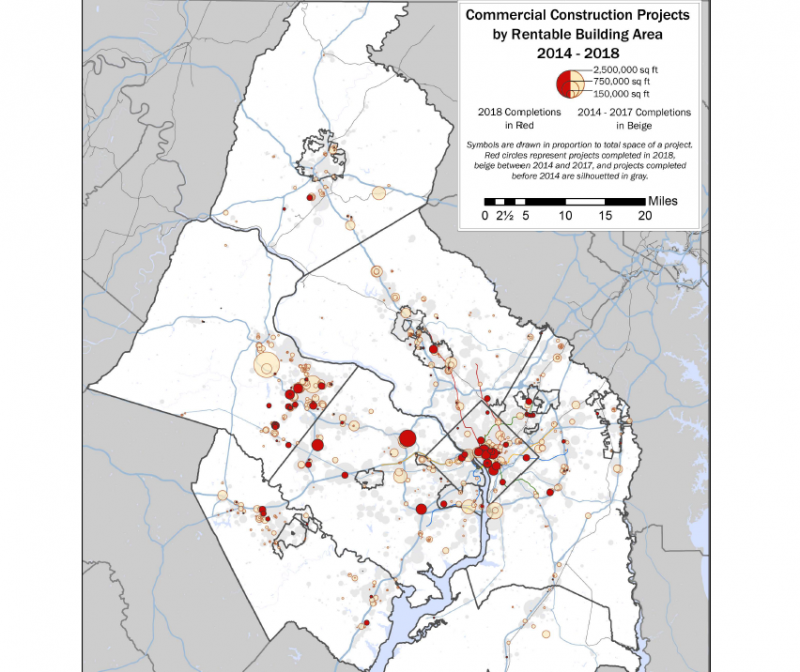Commercial real estate construction is slowing in our region, except near Metro stations

DC Construction by Paul Sableman licensed under Creative Commons.
Commercial construction in the Washington region dropped 28% in 2018, according to a new report from the Metropolitan Washington Council of Governments (MWCOG). It shows there were 114 new commercial buildings in 2018, the lowest number since World War II. Much of the construction that is happening is occurring near metro stations.
The report looks at “non-residential” commercial projects in the region, including office, retail, industrial, flex, healthcare, religious, educational, utility, and some government properties. While 10.4 million square feet of construction were added, that figure is four million fewer square feet than in 2017. Although the slowdown is affecting all parts of the region, it is particularly pronounced outside of the metropolitan area’s core.
This has created a lopsided growth pattern of new commercial space, with most new construction occurring in the District, Fairfax County, and Loudoun County. In total, around a third of the new square footage is in the District, half of it is in Virginia, and the smallest amount is in Maryland.
Another concern that the report addresses is that commercial vacancy in the region, though improving, remains stubbornly high in comparison to the nation as a whole. In Arlington, for instance, the rate of commercial vacant space is among the highest in the area—at over 15%—despite Amazon’s move to the region.
The good news for urbanists is that an increasing amount of this commercial space will be near Metro stations. Twenty two buildings or 44% of all new square footage will be within a half mile of a Metrorail station, according to the report. And there are other interesting caveats.
First, a large amount of the new offices and hotel space is moving in near transit in DC, whereas the new commercial space in Loudoun County is for industrial uses, such as distribution centers, which might not be as well served by transit.
When you look at just office space there was also an increase of square footage for the third consecutive year. Of the 4.8 million square feet of office space, 82% was near a metro station, the report showed.
Also, the report does not seem to include stations in the Silver Line’s Phase II, which would likely mean even more jobs will be within reach of the Metro in coming years.
The report also includes some interesting information about the amount of commercial space near VRE and MARC stations. Much of the development within a half-mile of Maryland’s MARC or Virginia’s VRE stations occurred near stops that also had a Metrorail station, the report stated. Of the region’s 38 commuter rail station areas, 15 had at least one commercial construction project in the past five years, and eight of those 15 station areas also had a Metrorail station.
It lists major construction projects currently happening in the region, and there’s data to suggest that DC is slowly gaining a larger footprint in the region’s commercial space availability.
Although the demand for transit-friendly locations for office space in the region is clear, this also indicates an ongoing need for vigilance in planning to combat sprawl, and to connect new jobs with people in our region who need them the most. Since placing jobs near transit is one of the best ways to promote ridership and reduce climate change-causing emissions, this will be paramount for the future of our region.
What else did you notice in the report?
Correction: We had incorrectly named Metropolitan Washington Council of Governments (MWCOG) the Metropolitan Washington Coalition of Governments. This has been fixed.





